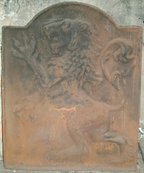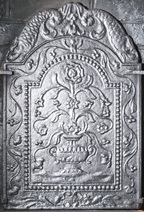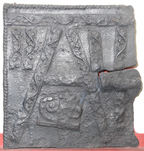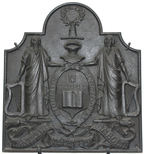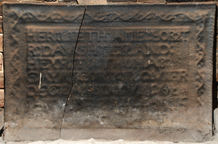-
22
Description: Arched rectangular shaped; fillet edging; a lion rampant
Notes: Whole pattern. A modern design of fireback
Copies of this fireback are known.
- Decoration tags:
- arched rectangular (shape)
- fillet (edging)
- whole carved pattern
- heraldic
- animals
Manufactured: in the late 19th to early 20th century in England.
Current location: St Mary's House, Bramber, West Sussex, England.
- Attached to series:
- Miscellaneous pattern firebacks
-
1230
Description: Arched rectangular central panel with bead-on-fillet edging; gadrooned vase with a quasi-symmetrical arrangement of fronds, leaves and flowers issuing therefrom, topped by a central bloom; arched rectangular border with fillet edging and a quasi-symmetrical arrangement of fronds, leaves and flowers descending from top centre; at the bottom, leaves splayed from a central cartouche enclosing an indecipherable initial or monogram; on top, symmetrical sea serpents descending from a central beribboned pendant.
Notes: A familiar type of design seen on many small firebacks/gratebacks of this period.
Inscription: [indecipherable]
Manufactured: in the early 18th century in England.
Current location: Godinton House, Great Chart, Kent, England.
- Attached to series:
- British 'Dutch' style firebacks
-
1137
Description: Arched shape with ovolo-moulded edging; central shield with the English royal Tudor arms and an inescutcheon of a lion rampant, surrounded by a Garter with an incorrect inscription, the shield surmounted by a crown and supported on the dexter side by a dragon and on the sinister side by a greyhound; to the left of the crown, a crowned rose and the the right, a crowned portcullis; above the supporters the date 1614 is split by the shield; below, split by the Garter buckle, initials GB.
Notes: The arms are of Henry VII or Henry VIII, the inescutcheon probably representing a marriage to an heiress, but are anachronistic as the date was in the reign of James I (and VI). The initials GB are believed to relate to Gilles or Georges Boniver, who worked at the foundry at Theux, near Liège, and whose initials appear on several firebacks. The fireback is thought to be a 19th-century copy.
Copies of this fireback are known.
Inscription: 16 14 / HONI SOIT IL QVIMAL I PANSE / G B
Arms: English royal Tudor with an inescutcheon of a lion rampant
Manufactured: in 1614 probably at Theux Furnace in the Franchimont area of Belgium.
Current location: M-Museum Leuven, 28-30 Leopold Vanderkelenstraat, Leuven, Brabant, Belgium.
(part of the Leuven Museum museum group)
-
381
Description: Fragment; left part of rectangle; twisted rope border (top and sides); long, narrow stamp with undulating vine motif, repeated three times in 'A' shape with top bar; short length of same strip repeated six times, one across middle of 'A', two each side of 'A' at top, one lower right; indistinct stamp with swirled floral design between lower legs of 'A'.
Notes: The same vine strip stamp is seen, in both long and short lengths, on many firebacks, indicating a common source. All the stamps were probably derived from redundant furniture.
- Decoration tags:
- sub-rectangular (shape)
- rope (edging)
- simple stamps
- objects
Manufactured: in the mid to late 16th century possibly at Pounsley Furnace, Framfield in the Weald area of England.
Current location: Anne of Cleves House, Southover High Street, Lewes, East Sussex, England.
Museum number: LH000.913 (part of the Sussex Archaeological Society museum group)
- Attached to series:
- Pounsley series
- Vine strip series
- Furniture stamp firebacks
-
1082
Description: Arched rectangular central panel; fillet edging; pictorial scene of a phoenix rising from a fire; above right, a human mask at the centre of a sunburst; arched rectangular border with fillet edging, the date between initials along the bottom; down each side, a floral festoon hanging from a ring; over the arch, the inscription; on top, floral scrolls.
Notes: The inscription translates as 'out of death, immortality'; the initials NL are likely to be those of the pattern maker. Skinner's, Marlborough, Massachusetts, auction 14 Aug 2016 lot 226.
Inscription: EX MORTE IMMORTALITAS / N 1696 L
- Decoration tags:
- 'Dutch' (shape)
- fillet (edging)
- carved pattern panels
- pictorial
- mythological
- text
- animals
Manufactured: in 1696 possibly in the Siegerland area of Germany.
Current location:, not known.
- Attached to series:
- 'Dutch' 1696 NL series
- Phoenix firebacks
-
772
Description: Cavetto canted arched rectangle; astragal edging; oval inscription surrounding a central battlemented shield bearing an open book, with a baronet's escutcheon above; above, a helm with a crest of an arm and hand holding a wreath; on each side, a druid supporter holding a harp, each upon a horizontal fillet; below, intertwined bell flowers behind a tripartite motto scroll.
Notes: The motto appears to have been incorrectly spelled; the Conroy baronetcy was created for Sir John Conroy, comptroller of the household of the Duchess of Kent, and much hated by her daughter, Princess (later Queen) Victoria; the 3rd (and last) baronet succeeded to the title in 1869.
Inscription: FIDELITER ET CONSTANTER [Faithfully and constantly] / L'ANTIQIVITE NE PEVX PAS L'ABOLIR [Antiquity cannot abolish it]
Arms: Conroy, baronet, of Llanbrynmair (Sir John Conroy, 3rd baronet, 1845-1900)
- Decoration tags:
- cavetto-canted arched rectangular (shape)
- astragal (edging)
- whole carved pattern
- armorial
- text
- humans
Manufactured: in the late 19th century in England.
Current location: Victoria & Albert Museum, Cromwell Road, Kensington & Chelsea, Greater London, England.
Museum number: 502.1896 (part of the Victoria & Albert Museum museum group)
- Attached to series:
- Personal armorial firebacks
- Welsh armorial firebacks
-
1052
Description: Rectangular; rope edging on top and sides; central inscription panel; repeated trailing vine decoration from impressed wooden strips — one horizontal line at top, one vertical strip at each side.
Notes: The inscription panel is identical to that on the memorial plate to Anne Forster in Crowhurst church, Surrey; at least ten other firebacks are known with the same inscription panel. Formerly at Stonelands, West Hoathly.
Inscription: HER : LIETH : ANE : FORST/ R : DAVGHTER : AND : / HEYR : TO : THOMAS : / GAYNSFORD : ESQVIER / DECEASED : XVIII : OF: / IANVARI : 1591 : LEAVYNG / BEHIND : HER II : SONES : / AND : V : DAVGHTERS
- Decoration tags:
- rectangular (shape)
- rope (edging)
- simple stamps
- carved pattern panels
- text
- plants
Manufactured: in the late 16th century possibly at Pounsley Furnace, Framfield in the Weald area of England.
Current location: The Old Parsonage, North Lane, West Hoathly, West Sussex, England.
